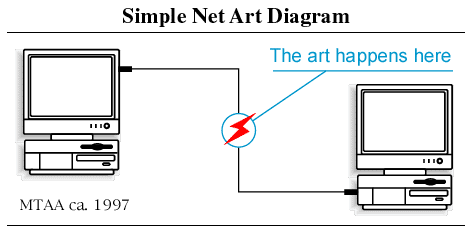This is part two of a two-part series about the net art network. The first part covered its beginnings and ideological basis. This post will look at how net art has evolved and the present landscape, drawing on new media theories and current artists’ exhibitions. Once a place of utopian possibility, current net artists see the internet as a root cause of today’s social, political, and economic inequalities.
An Introduction to the Net Art Network: Part 1
With more critiques of large internet companies gaining traction, people are beginning to question the hegemonic nature of the internet and the power structures that exist on the web, both of which define net art as school of thought. It is the work of net artists to develop, critique, and re-imagine the development of human experience as it relates to and exists on the web. This post gives an overview of net art and two examples of early net artists.
Connections and Gaps between Artists’ and Institutions’ New Media Preservation Efforts
Media art, which frequently involves data, software, or electronic devices, keeps facing the challenge of technological obsolescence. Since preservation and conservation are fields often dominated by museums and similar organizations, a contrast exists between personal and institutional practices. In some cases, artists rely on museums for technological support. This article looks at new media artists’ firsthand experiences and media artworks donated to the MoMA.
Opportunity or Challenge? Artificial Intelligence for Museum Audience Engagement
To improve museum operations, museum management is increasingly taking advantage of artificial intelligence (AI) technology to understand their collection data, their visitors, and their exhibitions. Audience engagement is one of the most significant factors that museums need to consider in their operations: it is an implicit element that connects people to collections and should be achieved based on a deep understanding of visitors, collections, and exhibitions. Within the past few years, AI technologies have shown their potential to bring previously inaccessible insights to museums based in three main areas: machine learning, chatbots, and neural networks.
Considering Biases in AI and the role of the Arts
The Role of Technology in Museums
With tools like beacons, iPads, touch screens, and haptic interfaces, technology provides museumgoers with detailed information, customized viewing experiences, and precise location mapping services. However, the use of digital technology in museums is often seen as a double-edged sword, which begs the question: does technology really belong in museums?
Redefining Boundaries at the Museum: Crowdsourced Exhibition at the Santa Cruz Museum of Art and History
Since December 19, 2014 the Santa Cruz Museum of Art and History has featured an exhibit of works relating to the ocean, with painting and sculptures by established artists alongside works by local residents. The exhibit includes a wide variety of art, ranging from professional artists’ works to two year-olds’ drawings. Everybody’s Ocean is a partially crowd-sourced and partially curated exhibition presenting everyone’s personal relationship with the sea.
Viewpoint of Billions
Wearable technology is all anyone is interested in talking about these days, and certainly AMT Lab is no different (for example, see Performing Arts in the Wearable Age). I’d like to take a brief interlude from gossiping about when Apple’s smart watch is going to drop to refocus on an “older” wearable technology: Google Glass.
Let me preface this by saying I am not an Explorer (or a Glasshole–whichever floats your boat) but as a casual observer of technology, I’ll jump at the chance to try something new. Like Google Glass. So when the National Portrait Gallery offered me (and the rest of DC) the chance to do just that, you bet I went for it.
Implementing a New Collection Management Application: Colección FEMSA
Colección FEMSA specializes in travelling exhibitions for Mexican and international institutions. A nine-person team manages all aspects of planning, from building crates and preventive conservation to facilitating partnerships with museums and other cultural organizations, culminating in up to twelve different shows each year. While a relatively small collection, the management challenge for this organization is having artwork constantly on the move. This case study concentrates on how Colección FEMSA meets this challenge through the help of a collection management application, Spaces for Art.
A Virtual Orchestra
The Australian Chamber Orchestra (ACO) has teamed up with Sydney digital media company Mod Productions to produce a new interactive “virtual orchestra” that is breaking down audience barriers in the music world. The resulting audio-visual installation, “ACO Virtual,” has created the means to bring the Orchestra outside the concert hall and into spaces where the ACO may not perform.















